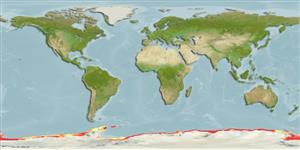>
Perciformes/Notothenioidei (Icefishes) >
Nototheniidae (Cod icefishes) > Trematominae
Etymology: Trematomus: Greek, trematos = hole + Greek, tomo = section, cut (Ref. 45335).
Eponymy: Professor Axel Johan Einar Lönnberg (1865–1942) was a Swedish zoologist who mainly worked at the Vertebrate Department of the Swedish Museum of Natural History in Stockholm. [...] (Ref. 128868), visit book page.
More on author: Regan.
Issue
The genus Pseudotrematomus is a synonym of Trematomus, which is confirmed by a molecular study to be published (J.-C. Hureau, pers. comm. 08 Jun. 2010).
Environment: milieu / climate zone / depth range / distribution range
Ecología
marino batidemersal; rango de profundidad 0 - 1191 m (Ref. 45168), usually 65 - 832 m. Deep-water; 61°S - 78°S, 180°W - 180°E
Southern Ocean: coasts of Antarctic Peninsula, Queen Mary, Adelie, South Victoria Coasts, Davis, Ross and Weddell seas.
Tamaño / Peso / Age
Maturity: Lm ? range ? - ? cm
Max length : 30.0 cm SL macho / no sexado; (Ref. 5179); common length : 20.0 cm NG macho / no sexado; (Ref. 45168); peso máximo publicado: 357.40 g (Ref. 124149)
Espinas dorsales (total) : 5 - 7; Radios blandos dorsales (total) : 31 - 35; Radios blandos anales: 31 - 35. Body brownish, fins darker except first dorsal. With 4 or 5 irregular darker cross-bars, inside of mouth and branchial cavities blackish (Ref. 11892).
Found more commonly at depths greater than 300 m. Adults feed on amphipods (mainly Orchomene plebs), errant polychaetes, and in lesser amounts, fishes. Isopods and other crustaceans are probably included in the diet.
Dewitt, H.H., P.C. Heemstra and O. Gon, 1990. Nototheniidae. p. 279-331. In O. Gon and P.C. Heemstra (eds.) Fishes of the Southern Ocean. J.L.B. Smith Institute of Ichthyology, Grahamstown, South Africa. (Ref. 5179)
IUCN Red List Status (Ref. 130435: Version 2024-1)
Threat to humans
Harmless
Human uses
Pesquerías: sin interés
Herramientas
Special reports
Download XML
Fuentes de Internet
Estimates based on models
Preferred temperature (Ref.
123201): -1.9 - 1.2, mean -0.9 °C (based on 2083 cells).
Phylogenetic diversity index (Ref.
82804): PD
50 = 0.5005 [Uniqueness, from 0.5 = low to 2.0 = high].
Bayesian length-weight: a=0.00427 (0.00266 - 0.00685), b=3.25 (3.11 - 3.39), in cm total length, based on LWR estimates for this species & Genus-body shape (Ref.
93245).
Nivel trófico (Ref.
69278): 3.3 ±0.48 se; based on food items.
Resiliencia (Ref.
120179): Medio, población duplicada en un tiempo mínimo de 1.4-4.4 años (Fec = 5,900).
Fishing Vulnerability (Ref.
59153): High vulnerability (61 of 100).
